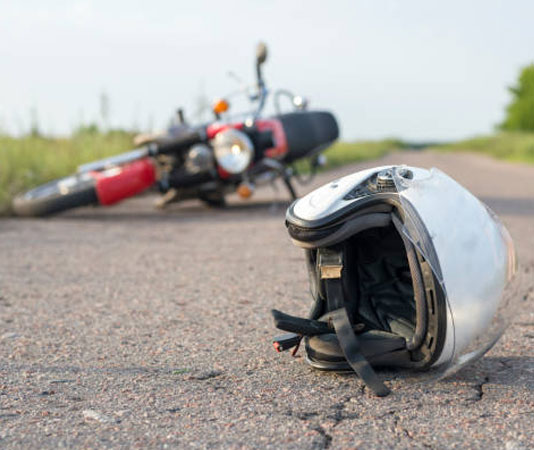Driving down the open highway, most motorists rarely consider small objects like bits of tire, metal shards, spilled nails or strips of plastic as major safety hazards. However, for motorcyclists sharing the roads, these scraps of debris actually present an immense threat. When struck at high rates of speed, even minor chunks of rubber, metal or plastic can prove lethal to bikers. Without the protections of size, structure and safety features shielding cars and trucks, motorcycles and their riders are extremely vulnerable to roadway debris. Tragically, many riders lose their lives each year to seemingly harmless litter scattered across pavements.
The Dangers of Road Debris
Unlike larger vehicles, motorcycles provide little shielding for riders in the event of collisions. They lack reinforced steel frames, air bags, collapsible front ends and other safety structures built into cars and trucks. When a motorcycle hits an object on the roadway, the effects can be devastating on both human bodies and bikes. Striking debris at high speeds typically causes riders to lose control – veering sharply, braking too hard or getting flung from bikes. Usually the end result is a series of brutal impacts between flesh and road that few survive. With no seat belts, handlebars and high centers of gravity make being thrown especially dangerous. Whether from immediate crash injuries or crushing slides along the pavement, without the protections of bigger vehicles, motorcycle riders suffer catastrophic consequences from debris.
Common Types of Deadly Debris
There are three predominant forms of litter on highways that prove particularly hazardous for motorcycles:
Tire Treads – As tires wear thin from use, hardened rubber strips and chunks sometimes peel away or rupture suddenly. These wayward treads create slippery stretches of road that cause bikes to fishtail and spill easily. Loss of control accidents tend to be deadly due to extreme speeds and instability when riding on just two wheels.
Spilled Cargo – Accidents involving spilled cargo from vans, trucks and trailers generate huge quantities of debris instantly across highways. Building supplies, tools, appliances and landscaping materials crashing across roads create minefields of hazards for bikers. Striking lumber, pipes, ladders or tools often has enough blunt force at 70 mph to kill riders immediately.
Scrap Metal – Fender benders resulting in scattered shards of metal, glass, plastic and synthetics also create instability for motorcycles. While cars and trucks can absorb hits from small scraps, even a single bolt, stone chip or bit of a headlight lens carries enough power on impact to send a bike lurching sideways if it is struck while speeding down roads.
Factors Leading to Accidents
Several common factors contribute significantly to motorcycles striking debris on highways:
Speed Differentials – The high velocities motorcycles often travel at make adjusting course extremely difficult the moment debris appears in their path up ahead. With faster speeds, motorcycles crash into scattered bits of tire, nails or glass that cars ahead may miss or avoid since they see them sooner at slower paces.
Limited Visibility – Road litter like nails, glass shards and tiny mechanical parts blend into pavements, becoming virtually invisible. Their small size relative to the road makes spotting them extremely difficult. The effects of lighting, size differentials, color contrast and speed all limit a motorcyclist’s ability to detect such debris up ahead.
Driver Negligence – Collisions resulting in spilled cargo loads or metallic scraps scattering across roads almost always originate from some form of driver error. Speeding, distraction, recklessness and intoxication while operating vehicles leads to crashes that produce debris. Unsafe vehicles, ignored maintenance issues, and improperly secured loads also contribute significantly to highway litter according to traffic safety studies.
Preventing Motorcycle Debris Accidents
Since motorcyclists face amplified threats from debris with minimal protection, riders must take added precautions by moderating speed, enhancing bike visibility and constantly scanning for road hazards. However, drivers of cars and trucks also play a major role in preventing these gruesome accidents.
Safe Driving Habits – Motorists must make safety the top priority whenever behind the wheel of any vehicle. Obeying speed limits, avoiding distractions, properly maintaining vehicles and keeping eyes focused on the road drastically reduces collision risks that create debris spillage. Also, confirming cargo loads are well-secured helps lower hazards for bikes.
Prompt Debris Removal – Being attentive by clearing accident scenes of any scattered bits of metal, broken glass and remnants eliminates continued threats. Calling emergency services for assistance cleaning up debris helps prevent further crashes.
Motorcycle Awareness – Making an effort to notice motorcyclists by checking blind spots before changing lanes, allowing safe following distances and always utilizing turn signals prevents causing a collision with a bike that could potentially strew debris across the road.
Seeking Legal Assistance
In the aftermath of motorcycle debris accidents, extensive injuries, emotional trauma, funeral costs, loss of income and destroyed vehicles often leave families in dire circumstances. But there are options for attempting to recover damages by seeking financial compensation. Those impacted by debris accidents should contact a qualified personal injury lawyer or wrongful death attorney to fully understand their rights around potentially pursuing negligence claims. An experienced motorcycle accident attorney can help victims and families explore options for settlements, insurance claims or jury awards. With comprehensive legal guidance, victims can focus on healing physically and emotionally despite devastations, while lawyers handle battling for fair restitution.
In Summary
Small scraps of rubber, metal and synthetics may appear harmless to typical motorists cruising in large, protected trucks and SUVs. But experiencing the force of something as minor as a stone chip, nail or bit of plastic at 70 mph on a motorcycle turns debris into deadly projectiles. Though riders must stay vigilant for litter, implementing safe driving and debris clearing practices can help reduce accidents substantially. However, when crashes still occur due to driver negligence, seeking qualified legal representation immediately is critical for victims and families to help ensure needs are fully addressed while pursuing fair outcomes during vulnerable times.
If you’ve been involved in a motorcycle accident caused by debris, contact us today. You can visit our office at 536 Pacific Avenue, San Francisco, CA 94133 or call now for a free consultation on (415) 352-6264.

